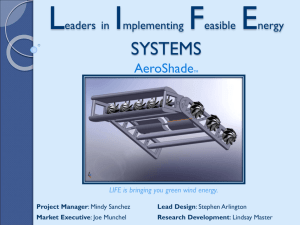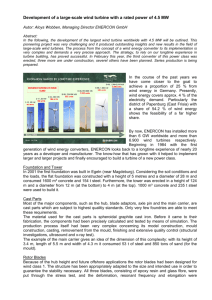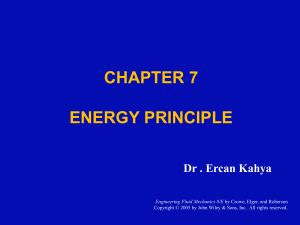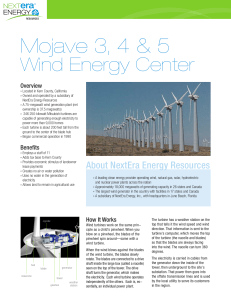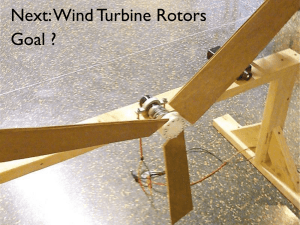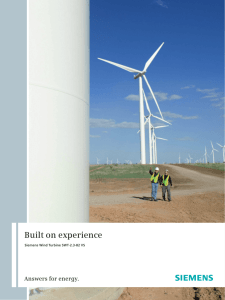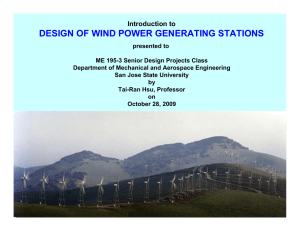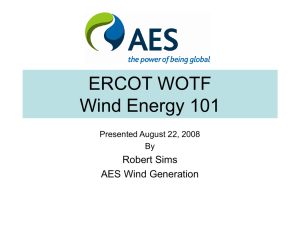Wind - simple physics
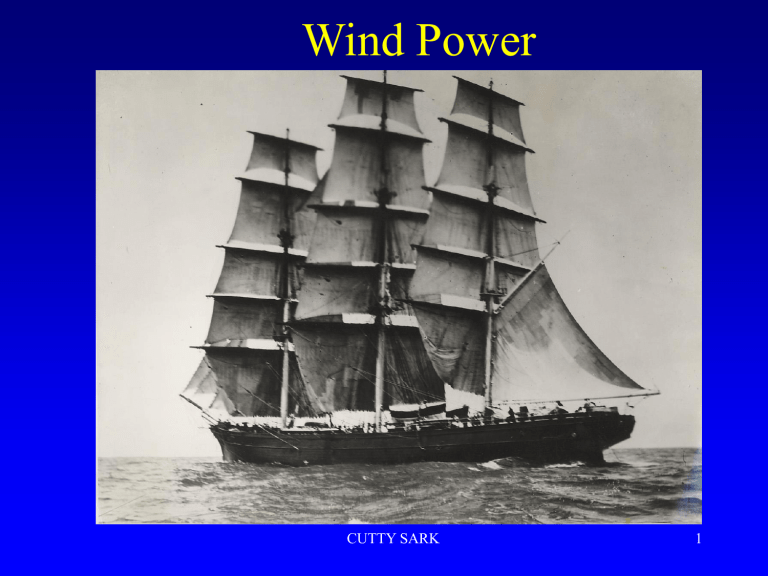
Wind Power
CUTTY SARK 1
Weibull Distribution
Weibull Distribution Plotter Programme
2
LECTURE NOTES BY PROFESSOR J L CAMPBELL
University of Guelph
Wind - simple physics
• Wind velocity = v: blade radius = R
•
Blades sweep out area A = π R 2
•
Air density = ρ
•
Mass of air arriving per second = M = A v ρ
• Its KE is ½ M v 2 = ½ A v 3 ρ
• Want large swept area ie long blades
•
The v 3 factor is very favourable in high-wind regions
•
Cold air is denser - better - implies higher towers
3
Weibull Distribution……….
• Asymmetric – high winds are less probable than low
• But high wind speed means much more power (v 3 )
• You CANNOT just substitute the average wind speed into the equation for power output of turbine
• You must add up the power increments at each wind speed on the distribution
• This typically doubles the calculated power output!
4
• BUT if you somehow extracted all the kinetic energy, the air would stop dead after the rotors no more air could arrive - not realistic!
• You can only extract some fraction less than 100% of the energy
5
Profile of air flow
• Mass of cylinder of air arriving from right is
M1 =v
1
π r
1
2 ρ
• Cylinder exiting at left has decreased velocity, so
M2 = v
2
π r
2
2 ρ
• But obviously M1 and M2 are the same
• Therefore r
2 is larger than r
1
: the cylinder of air is wider downstream of the turbine
• This helps determine spacing of wind farms
6
Efficiency calculation: Bettz’ law
• Wind approaches rotor, perpendicularly, at velocity v
1
• Some energy is extracted, so velocity falls to v
2
• Assume mean speed through actual rotor is the average ie v m
= 0.5 (v
1
+ v
2
)
• Mass passing through per sec is m = v m
• Power extracted = 0.5 m v
= 0.5 v m
1
2 - 0.5 m v
A ρ (v
2
2
1
2 - v
2
2 )
A ρ
• P = 0.25 A ρ (v
1
+ v
2
) (v
1
2 - v
2
2 )
• If there were no rotor, undisturbed power would be P
0
= 0.5 A ρ v
1
3
7
1916
• Write v
2
/v
1
= x
• Then ratio R = P/P
0
= 0.5 (1 - x
• R is maximum when dR/dx = 0
2 ) (1 + x)
• Do this. Find that x = 1/3, corresponding to
R = 0.59
• So we get maximum efficiency of 59% at v
2
/v
1
= 1/3
• and Power P = 8 A ρ v
1
3 /27
• Issue of tower spacing in a wind farm
8
5
6
7
3
4
Power class
1
2
Wind speeds and location criteria
Average speed m/s
< 5.6
5.6 – 6.4
6.4 – 7.0
7.0 – 7.5
7.5 – 8.0
8.0 – 8.8
> 8.8
Power density
W/m 2
0 – 200
200 – 300
300 – 400
400 – 500
500 – 600
600 – 800
> 800
9
Wind speeds and location criteria……..
• Average speed at Danish installations (ie most advanced country) is 6.3 m/s
• Average SW winds on shores of Great Lakes are to 8 m/s
• In USA there are 232,000 square kms of Class 4 land within 10 km of existing transmission facilities, ie 8 times more land than for Classes
5+6 combined. Effort must focus on Class 4 areas
10
Wind speeds……:Mapping the resource
These figures are very similar to Germany, where installation is proceeding rapidly
11
Wind - environmental impact
• No air pollution
•
Electromagnetic interference eliminated via nonmetallic blades
•
Bird-kills decreased by move from lattice to tubular towers - average is 2.2 birds per turbine per year - less than office towers
•
Main accidents are falls
•
Noise much decreased - almost none at 200 m
•
Compatible with farming, recreation, forestry
•
Only 1-2% of land is actually “occupied” - can cultivate to within a few metres of a tower
12
Wind - installations 1
13
Cost issues
Canadian Wind Energy Association
14
Wind installations…….2
15
16
Cost issues……….
• AWEA/DOE cite USA wind generation cost as 3.9 – 5 cents(US) per kWh in 2002
• That is 5.3 – 6.8 cents Canadian
• Compare Ontario legislated price of 4.3 c, which is much less than true cost, and which is scheduled to rise
17
Costs are dropping
• Blades are lighter - towers can be higher: 50-90 m tubular towers
• Lower O/M costs; higher reliability; 25-30 y lifetime
• Bigger turbines: half of new ones now exceed 1
MWe
• Early 1980’s cost C$0.55 per kWh
• 2000 cost C$0.06 per kWh
• General observation in technology: Costs decrease
20% when # of units produced doubles
• World capacity likely to double in 5 y
18
Design issues
• Tower height is crucial: wind speed at 60 m height can be 20-60% greater than at ground level
• Heavy cold air gives up to 15% more power
• Site at end of large flat areas eg Great Lakes
• Seek large blade area
• Materials must withstand shear stresses
• Should rotate to align with changing wind direction
19
Capacity Factor
• Another way of stating the annual energy output from a wind turbine is to look at the capacity factor for the turbine in its particular location. By capacity factor we mean its actual annual energy output divided by the theoretical maximum output, if the machine were running at its rated (maximum) power during all of the 8766 hours of the year.
20
126 m diameter
5 MW
21
Mapping the wind resource….
• Wind speed is only the first part of picture. It is power that matters, and what about direction?
• “Wind rose” concept – see website of Danish
Wind Power association
• Divide a circle into 12 quadrants representing 12 measures of wind direction in 30 degree segments of the full 360
•
Give each a radius corresponding to the wind speed
22
Mapping the wind resource….
• Change to using velocity-cubed and make the radius of each quadrant proportional to the velocity-cubed from that direction – plot in red
• Adjust so that the sum of these v 3 values is 100%
• Now you are showing the power distribution around 360 degrees, both in direction and magnitude
• Data for a wind-rose must be averaged over several years – eg from European Wind Atlas
23
24
25
Supply versus demand issue
• Annual capacity factor 25-35%
• High winter winds plus cold dense air match maximum demand, especially for heating buildings
• 68% of Ontario production would be in October -
March
• High winter availability counteracts high costs of other sources
• BUT on still, humid summer day, wind is zero and air-conditioning demand is maximum
26
27
28
US Department of Energy
29
23. 04. 2009. | 18:29
Obamin veliki zaokret prema izvorima energije
U SADu će ‘svijetliti’ vjetar, plima i oseka
Autor Sergej Županić
Američki predsjednik u vjetroelektrani u Iowi najavio smanjenje emisije CO2 83 posto do 2050, 20% do 2020.
Barack Obama pozvao je na Dan planeta Zemlje svoju naciju na početak “nove ere u uporabi energije”, što bi unaprijedilo očuvanje okoliša i potaknulo gospodarski razvoj te otvaranje novih radnih mjesta.
30
Published online 11 February 2009 |
Nature 457
, 775 (2009)
News in Brief
Wind producers around the world installed more than 27 GW
32
33
34
Integrating power into grid
35
36
37
38
39
40
41
42
43
44
45
46
47
48
49
Nominalna snaga: 5,6 MW
(7 vjetrogeneratora od 850 kilowata)
Realizirana snaga: 1.06 MW -> 19%
1MW, 7M Eura -> 7Eura/W snage
50

